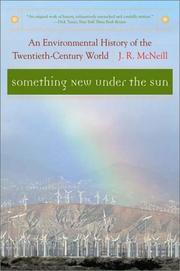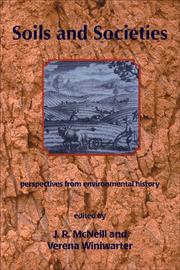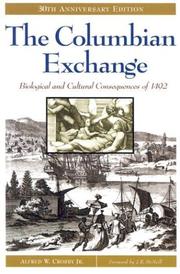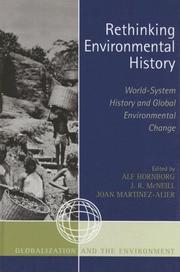| Listing 1 - 10 of 14 | << page >> |
Sort by
|

ISBN: 0393321835 Year: 2001 Publisher: New York, N.Y. Norton
Abstract | Keywords | Export | Availability | Bookmark
 Loading...
Loading...Choose an application
- Reference Manager
- EndNote
- RefWorks (Direct export to RefWorks)
Multi
ISBN: 9780674970731 9780674545038 Year: 2016 Publisher: Cambridge, Mass. Harvard University Press
Abstract | Keywords | Export | Availability | Bookmark
 Loading...
Loading...Choose an application
- Reference Manager
- EndNote
- RefWorks (Direct export to RefWorks)
Book
ISBN: 0674545036 0674970748 067497073X 9780674970731 9780674970748 9780674545038 Year: 2014 Publisher: Cambridge, MA : Harvard University Press,
Abstract | Keywords | Export | Availability | Bookmark
 Loading...
Loading...Choose an application
- Reference Manager
- EndNote
- RefWorks (Direct export to RefWorks)
The pace of energy use, greenhouse gas emissions, and population growth has thrust the planet into a new age—the Anthropocene. Humans have altered the planet’s biogeochemical systems without consciously managing them. The Great Acceleration explains the causes, consequences, and uncertainties of this massive uncontrolled experiment.
Nature --- Human ecology --- Global environmental change --- Effect of human beings on --- History --- Environmental change, Global --- Global change, Environmental --- Global environmental changes --- Change --- Ecology --- Environment, Human --- Human beings --- Human environment --- Ecological engineering --- Human geography --- Social aspects --- Effect of environment on --- Ecología humana --- Climatic changes --- Socioecología --- Supervivencia (Ecología humana) --- Medio ambiente humano --- Ecología --- Geografía humana

ISBN: 9781874267522 Year: 2006 Publisher: Isle of Harris White Horse
Abstract | Keywords | Export | Availability | Bookmark
 Loading...
Loading...Choose an application
- Reference Manager
- EndNote
- RefWorks (Direct export to RefWorks)
Book
ISBN: 9781874267546 Year: 2006 Publisher: Isle of Harris The White horse Press
Abstract | Keywords | Export | Availability | Bookmark
 Loading...
Loading...Choose an application
- Reference Manager
- EndNote
- RefWorks (Direct export to RefWorks)
Book
ISBN: 9027487243 Year: 2003 Publisher: Utrecht Spectrum
Abstract | Keywords | Export | Availability | Bookmark
 Loading...
Loading...Choose an application
- Reference Manager
- EndNote
- RefWorks (Direct export to RefWorks)

ISBN: 9780275980924 0275980928 0275980731 Year: 2003 Publisher: Westport: Praeger,
Abstract | Keywords | Export | Availability | Bookmark
 Loading...
Loading...Choose an application
- Reference Manager
- EndNote
- RefWorks (Direct export to RefWorks)
The book The Columbian Exchange changed the field of history drastically and forever as well. It has become one of the foundational works in the burgeoning field of environmental history, and it remains one of the canonical texts for the study of world history. This 30th anniversary edition of The Columbian Exchange includes a new preface from the author, reflecting on the book and its creation, and a new foreword by J. R. McNeill that demonstrates how Crosby established a brand new perspective for understanding ecological and social events. As the foreword indicates, The Columbian Exchange remains a vital book, a small work that contains within the inspiration for future examinations into what happens when two peoples, separated by time and space, finally meet.
Indians --- Medical geography --- Biogeography --- Diseases --- Agriculture --- History --- Géographie médicale --- Découverte et exploration --- Géographie médicale --- Découverte et exploration --- History of civilization --- World history --- anno 1500-1799 --- anno 1800-1999 --- Geographical distribution of diseases --- Geographical pathology --- Geography, Medical --- Geomedicine --- Medical topography --- Pathology, Geographic --- Topography, Medical --- Geography --- Medical climatology --- World health --- Aborigines, American --- American aborigines --- American Indians --- Amerindians --- Amerinds --- Pre-Columbian Indians --- Precolumbian Indians --- Ethnology --- Areography (Biology) --- Geographical distribution of animals and plants --- Species --- Species distribution --- Biology --- Geographical distribution --- Civilization --- #A0509HI --- Public health --- Indiens d'Amérique --- Biogéographie --- Santé publique --- Maladies --- Histoire --- America --- Amérique --- Discovery and exploration --- History. --- Indigenous peoples --- Diseases. --- Indians - Diseases --- Indians - Agriculture --- Medical geography - History
Book
ISBN: 0691174148 1400885108 Year: 2017 Publisher: Princeton University Press
Abstract | Keywords | Export | Availability | Bookmark
 Loading...
Loading...Choose an application
- Reference Manager
- EndNote
- RefWorks (Direct export to RefWorks)

ISBN: 9780759110274 9780759110281 075911028X 0759110271 0759113971 1299762271 Year: 2007 Publisher: Lanham, Md AltaMira
Abstract | Keywords | Export | Availability | Bookmark
 Loading...
Loading...Choose an application
- Reference Manager
- EndNote
- RefWorks (Direct export to RefWorks)
Environmental protection. Environmental technology --- World history --- Global environmental change --- World history. --- History.
Book
ISBN: 3030174395 3030174387 Year: 2019 Publisher: Cham : Springer International Publishing : Imprint: Palgrave Macmillan,
Abstract | Keywords | Export | Availability | Bookmark
 Loading...
Loading...Choose an application
- Reference Manager
- EndNote
- RefWorks (Direct export to RefWorks)
The fate of towns and cities stands at the center of the environmental history of World War II. Broad swaths of cityscapes were destroyed by the bombing of targets such as transport hubs, electrical grids, and industrial districts, and across Europe, Asia, and the Americas, urban environments were transformed by the massive mobilization of human and natural resources to support the conflict. But at the same time, the war saw remarkable resilience among the human and non-human residents of cities. Foregrounding the concept of urban resilience, this collection uncovers the creative survival strategies that city-dwellers of all kinds turned to in the midst of environmental devastation. As the first major study at the intersection of environmental, urban, and military history, The Resilient City in World War II lays the groundwork for an improved understanding of rapid change in urban environments, and how societies may adapt.
World War, 1914-1918 --- European War, 1914-1918 --- First World War, 1914-1918 --- Great War, 1914-1918 --- World War 1, 1914-1918 --- World War I, 1914-1918 --- World War One, 1914-1918 --- WW I (World War, 1914-1918) --- WWI (World War, 1914-1918) --- History, Modern --- Environmental aspects. --- World War, 1939-1945. --- Environment. --- Cities and towns-History. --- World history. --- Military history. --- History of World War II and the Holocaust. --- Environment Studies. --- Urban History. --- World History, Global and Transnational History. --- History of Military. --- Military historiography --- Military history --- Wars --- Historiography --- History --- Naval history --- Universal history --- European War, 1939-1945 --- Second World War, 1939-1945 --- World War 2, 1939-1945 --- World War II, 1939-1945 --- World War Two, 1939-1945 --- WW II (World War, 1939-1945) --- WWII (World War, 1939-1945) --- Cities and towns—History. --- Balance of nature --- Biology --- Bionomics --- Ecological processes --- Ecological science --- Ecological sciences --- Environment --- Environmental biology --- Oecology --- Environmental sciences --- Population biology --- Ecology --- Cities and towns --- Environmental Sciences. --- Military History. --- History.
| Listing 1 - 10 of 14 | << page >> |
Sort by
|

 Search
Search Feedback
Feedback About UniCat
About UniCat  Help
Help News
News